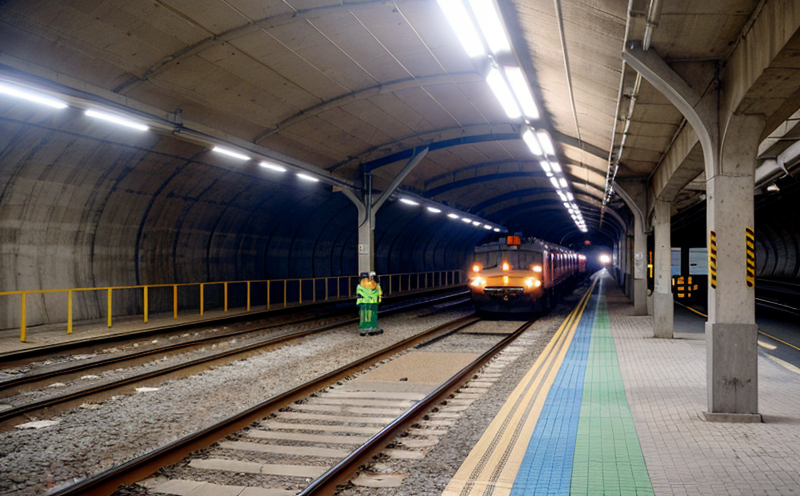EN 50122 Electrical Safety and Earthing Testing in Tunnels and Stations
The EN 50122 series of standards is crucial for ensuring the electrical safety and earthing systems within railway infrastructure. Specifically, EN 50122-7:2013 focuses on the technical requirements for electrical installations in tunnels, stations, and other similar structures used by railways.
The primary goal of this standard is to provide a framework that ensures the safety of personnel working in these environments while minimizing the risk of electrical hazards. This includes the installation, operation, and maintenance of electrical systems within railway infrastructure, particularly where high voltages are involved.
Testing under EN 50122-7 is essential for verifying compliance with international standards that prioritize safety. It encompasses various aspects such as insulation resistance testing, protective conductor continuity checks, and fault current calculation. These tests are critical in identifying potential issues before they escalate into accidents or failures.
The process involves detailed preparation of the test environment to replicate real-world conditions accurately. This includes setting up mock installations that mimic actual tunnel and station setups. Specimen preparation typically involves ensuring all components are correctly assembled according to design specifications, which is crucial for obtaining reliable test results.
Instrumentation plays a vital role in this testing process. High-precision measuring devices such as insulation resistance testers and earth continuity checkers are used to ensure accuracy. The instrumentation must be capable of handling the high voltages present in railway installations without compromising safety or measurement integrity.
The acceptance criteria for EN 50122-7 compliance are stringent, emphasizing both the technical performance of the electrical systems and their reliability under operational conditions. Acceptance is based on meeting all specified parameters outlined in the standard, including successful completion of insulation resistance tests, protective conductor continuity checks, and fault current calculations.
Implementing EN 50122-7 testing not only ensures compliance with international standards but also enhances safety and reliability within railway infrastructure. This is particularly important given the high voltage environments often encountered in tunnels and stations. By adhering to these standards, operators can significantly reduce risks associated with electrical faults or malfunctions.
The importance of this testing cannot be overstated, especially considering the critical nature of railway operations. Ensuring that all components meet stringent safety requirements helps maintain a safe working environment for personnel and prevents potential disruptions to service caused by equipment failures.
In conclusion, EN 50122-7:2013 is an indispensable standard for ensuring electrical safety in railway tunnels and stations. Its implementation involves meticulous preparation of test environments, precise instrumentation use, and strict adherence to acceptance criteria. By doing so, operators can enhance overall safety while maintaining reliable performance—a crucial aspect of modern railway infrastructure.
Quality and Reliability Assurance
The quality assurance process in EN 50122-7 testing is designed to ensure that all electrical installations within railway tunnels and stations meet the highest standards of safety and reliability. This involves several key steps aimed at preventing any potential hazards or failures.
- Initial Design Review: Before any installation begins, a thorough review of the design specifications is conducted to ensure they comply with EN 50122-7 requirements.
- Component Selection: High-quality materials and components are selected based on their durability and ability to withstand harsh environmental conditions typical of railway environments.
- Installation Supervision: Skilled technicians oversee the installation process, ensuring each step adheres strictly to predefined procedures.
- Post-Installation Testing: Rigorous testing is conducted post-installation using advanced instrumentation. This includes insulation resistance checks and protective conductor continuity verifications.
By following these stringent measures, operators can confidently ensure that their electrical installations not only meet but exceed safety expectations set forth by EN 50122-7. Regular audits and updates to the quality assurance protocols further reinforce this commitment to excellence.
Environmental and Sustainability Contributions
The implementation of EN 50122-7 testing contributes significantly to environmental sustainability within railway infrastructure by promoting safer, more efficient operations. By adhering strictly to these standards, railways can reduce the risk of electrical accidents and subsequent disruptions caused by equipment failures.
One key aspect is minimizing downtime through reliable performance. Reliable electrical systems ensure continuous operation without interruptions, which translates into reduced maintenance costs and increased operational efficiency. This not only benefits railway operators but also passengers who experience fewer delays and disruptions during their journeys.
In terms of energy consumption, robust earthing systems play a crucial role in optimizing power usage by preventing unnecessary losses due to faulty connections or poor insulation. Such optimizations contribute positively to overall environmental impact by reducing the carbon footprint associated with railway operations.
Moreover, compliance with EN 50122-7 helps create safer working environments for maintenance personnel and other staff involved in daily operations. Properly installed and maintained electrical systems reduce the likelihood of accidents or injuries, thereby enhancing workplace safety standards across the sector.
In summary, adhering to EN 50122-7 testing protocols promotes both operational efficiency and environmental responsibility within railway infrastructure. Through rigorous quality assurance practices and sustainable design considerations, railways can achieve safer, more reliable services while contributing positively to global sustainability goals.
Competitive Advantage and Market Impact
- Innovation Leadership: By staying ahead of regulatory changes and embracing best practices outlined in EN 50122-7, railway operators gain a competitive edge. This proactive approach demonstrates commitment to safety and quality, appealing strongly to stakeholders.
- Customer Trust: Demonstrating compliance with international standards builds trust among customers and partners. Railways that prioritize safety are more likely to attract reliable contracts and partnerships.
- Operational Efficiency: Reliable systems reduce maintenance costs and downtime, leading to improved overall efficiency. This translates into lower operational expenses and better resource allocation.
These factors contribute significantly to a railway operator's market position, making them more attractive to investors, customers, and regulatory bodies alike. Staying compliant with the latest standards also opens doors for future projects and collaborations, further enhancing long-term competitiveness within the sector.





